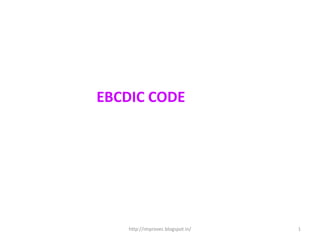
Ebcdic code 24 1
- 1. EBCDIC CODE http://improvec.blogspot.in/ 1
- 2. EBCDIC CODE It is pronounced as “ebb-see-dick” It is Extended Binary Coded Decimal Interchange Code It is standard code in large computers It is an 8-bit code without parity http://improvec.blogspot.in/ 2
- 3. EBCDIC CODE (contd) With 8-bits 256 characters can be coded Each digit has 1111 as the zone and its binary representation as numeric portion The alphabetic characters are divided into three groups having 1100,1101,1110 as the zone portion http://improvec.blogspot.in/ 3
- 4. Special Contd.. EBCDIC characters Alphabetic EBCDIC < 01001011 A 11000001 ( 01001100 B 11000010 + 01001101 C 11000011 / 01001110 D 11000100 & 01010000 E 11000101 : 01111011 F 11000110 # 01111011 G 11000111 @ 01111100 H 11001000 ‘ 01111101 I 11001001 = 01111110 J 11010001 “ 01111111 K 11010010 , 01101011 L 11010011 % 01101100 M 11010100 - 01101101 N 11010101 > 01101110 O 11010110 P 11010111 http://improvec.blogspot.in/ 4
- 5. Summary In this class, we have learnt about BCD Code ASCII Code EBCDIC Code http://improvec.blogspot.in/ 5
- 6. Frequently Asked Questions 1. Give the full forms to the following 1. BCD 2. ASCII 3. EBCDIC 2. What is the purpose of ASCII code ? http://improvec.blogspot.in/ 6
- 7. Quiz 1. What is the position of character ‘A’ in ASCII? a. 48 b. 65 c. 97 d. 32 ANSWER : b http://improvec.blogspot.in/ 7
- 8. Quiz (Contd...) 2. What is the position of character ‘0’ in ASCII? a. 48 b. 65 c. 97 d. 32 ANSWER : a http://improvec.blogspot.in/ 8